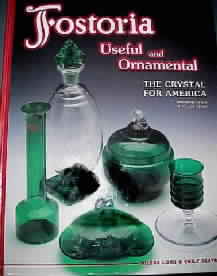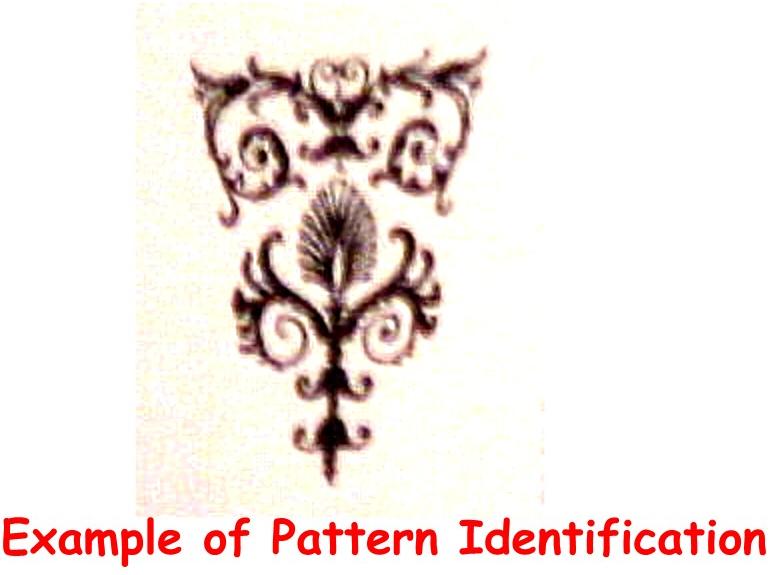|
|
|
|
|
|
|
|
|
|
 |
|
|
|
 |
 |
 |
| Fostoria: The Crystal for America |
| by Milbra Long and Emily Seate |
 |
|
|
 |
 |
 |
|
|
|
 |
 |
 |
| A Review by |
| Leonette A. Walls, Ed.D. |
 |
|
|
 |
|
|
|
 |
 |
 |
| In 1993, a monumental task was undertaken by Milbra Long and Emily Seate. The goal was to present the glass of Fostoria as comprehensively as possible. The task has now been completed with the fourth and final volume entitled Fostoria: Useful and Ornamental. This volume features barware and ornamental items that are not considered tableware. Included are candlesticks, candy jars and boxes, carved decorations, jugs and tankards, smoking accessories, figurals, and much more. The section featuring early lamps by Fostoria was a special favorite of the reviewer. One of the unique features of the fourth volume is the comprehensive indexing for all four volumes. |
|
| In studying the volumes for this article, only one feature seemed to be lacking in this collection. Although minimal, mention of this seemed appropriate; especially , so that the reader of the last volume will be aware of how to utilize volume four with the earlier volumes. Noted were selected items from patterns that did not list current pricing. The authors refer the reader back to previous volumes, i.e. (See Baroque), etc. Although this may not present a major inconvenience, possession of the tableware volumes will be necessary to check some prices. The bulk of the prices for items will appear on the page presented. |
|
| The first volume covered Fostoria Stemware , which is in its second printing. The comprehensive volume features computer generated illustrations, hand-drawn by a graphic artist, which makes identification easy for even the novice. The invaluable indexing of this book makes it extremely user-friendly and fills a need long over-due. The vast amount of readily accessible information is presented in a very scholarly manner, but simple to utilize. Pricing for patterns and pieces that were not previously available in such depth makes this volume an invaluable asset. This 269 page work also includes a picture index showing the shapes of Fostoria stemware. This 1998 volume is one of the reviewer's most used reference books. |
 |
|
|
 |
 |
 |
 |
 |
|
 |
|
|
|
 |
 |
 |
| The first volume of two on Fostoria's tableware, Fostoria Tableware (1924-1943) , features pressed patterns, brocade and master etchings, cuttings and decorations, some of which had not previously been identified. The format of the book denotes production dates and colors for every piece in every pattern. Featured are many catalog pages, some in color, and 125 color photographs of nearly 400 pieces. Vast information is presented in this much needed resource. Pattern identification continues to be an area that extensive information has been needed; this volume will definitely prove to be an excellent tool by presenting clear, factual information. The accurate documentation that is provided by the catalog pages will excite the "student" of Fostoria glassware. Pricing seems to be very in line with what is actually occurring in today's marketplace. Indexing is provided for the reader's convenience. Already, this a respected source of information on Fostoria wares. The hard cover book presents 336 pages with 1999 price values. |
|
| The second tableware volume, Fostoria Tableware (1944-1986), is presented in much the same format as the first tableware volume. Included are patterns and items produced from 1944 until the closing of Fostoria factory in Moundsville, West Virginia, in 1986. So many of these later patterns are not available in other available publications. As with the previous volumes, the pricing seems more in line with what is actually happening in the market place. Too often, the collector and dealer are faced with price guides that appear to be less than up-to date with actual selling prices. This 1999 publication features 309 pages , including a great section on milk glass by Fostoria, with plenty of color photographs. |
 |
|
|
 |
 |
 |
|
 |
|
|
|
 |
 |
 |
| It is clear from the content of this personal note from Emily Seate that a tremendous amount of love for Fostoria preceded the large scale project. The following insight into the completed project is quite touching: |
|
| " When Milbra and I first started these books, we intended to bring the reader accurate information in a usable format. However, when one works as closely with Fostoria as we have over the years, one cannot help falling in love with the shapes, the colors, the delicate etchings, the incredible decorations, as well as gaining tremendous respect for those who ran Fostoria and those who designed and made the glassware. |
|
| In addition, we became bolder in our presentation as did Collector Books, until finally in this last book, we have pulled out all stops, so that facts are coupled with fancy to create a delightful page-turner. Our goal evolved toward a need to inspire the reader to see Fostoria with new eyes, to dance with wonder through the pages filled with colorful history. This last book completes and illustrates our joyous love affair with Fostoria and its and practical and beautiful glassware." |
|
| With the completion of the four volumes, the years of 1924-1986 will have thoroughly and completely covered one of the greatest glass houses in American history, the Fostoria Glass Company of Moundsville, West Virginia. All volumes feature color and black and white photos and illustrations, plus a generous array of catalog pages. Collectors and dealers will be indebted to these highly professional ladies for many years to come. These volumes seem destined to become the hallmark of research data on the years of Fostoria glass production. |
|
| Milbra Long and Emily Seate are mother and daughter. Together they have committed their skills, knowledge, love of glass, and their time to provide the glass lover, collector and dealer with a great contribution to the literature on glassware. This reader says thank you to Milbra and Emily for all the joy that your books have brought to my love of glassware; their role in my learning experiences about Fostoria is immeasurable. What a legacy these authors have left for glass lovers! |
 |
|
|
 |
 |
 |
 |
 |
|

